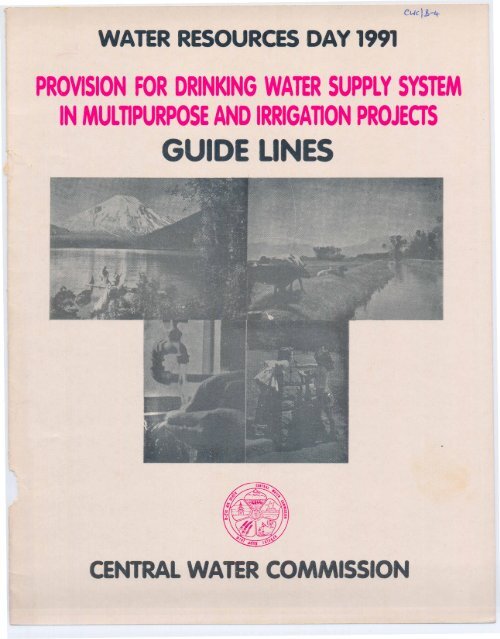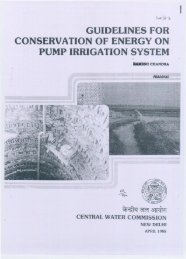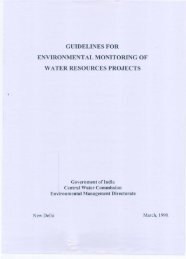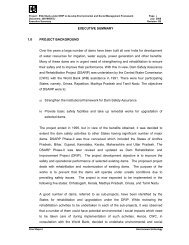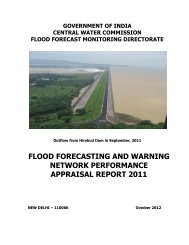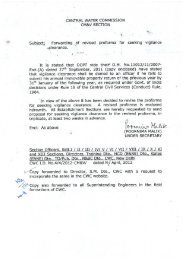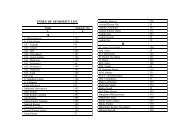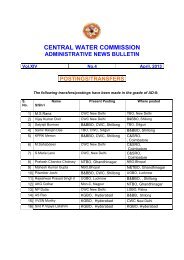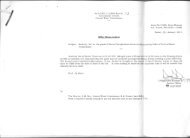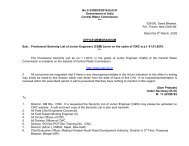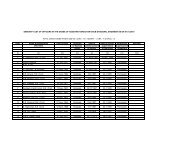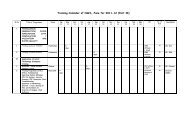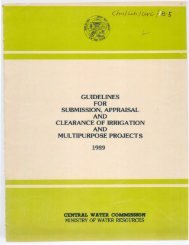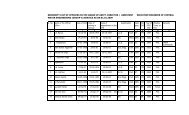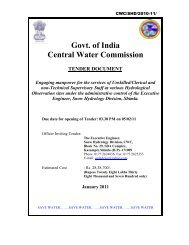GUIDE LINES - Central Water Commission
GUIDE LINES - Central Water Commission
GUIDE LINES - Central Water Commission
Create successful ePaper yourself
Turn your PDF publications into a flip-book with our unique Google optimized e-Paper software.
WATER RESOURCES ,DAY 1991<br />
PROVISION FOR DRINKING WATER SUPPLY SYSTEM<br />
IN MULTIPURPOSE AND IRRIGATION PROJEOS<br />
<strong>GUIDE</strong> <strong>LINES</strong><br />
CENTRAL WATER COMMISSION
PROVISION FOR DRINKING WATER SUPPLY SYSTEM IN<br />
MULTIPURPOSE AND IRRIGATION PROJECTS
Despite the National <strong>Water</strong> Policy adopting in<br />
1987, giving top priority for allocation of water for<br />
drinking purposes in the planning of irrigation and<br />
multipurpose projects and also that the States having<br />
recognised the same in their planning, it is felt that<br />
specific guidelines are formulated and issued as to the<br />
manner of integration of the system for supply of<br />
drinking water phys ically and operationally with the<br />
r::anal network, which would further facilitate in<br />
'accelerating the process. With this in view, the<br />
Project Appraisal Organisation of <strong>Central</strong> <strong>Water</strong><br />
Commi~ion have prepared these guidelines which, it is<br />
hoped, would prove useful.<br />
(C. Sudhindra)<br />
~1ember (P&P)<br />
<strong>Central</strong> <strong>Water</strong> <strong>Commission</strong>
Guidelines for integration of drinking<br />
water supply system<br />
2. 1 Setting up of multi -disciplinary<br />
units in the States<br />
2.2 Formulation of urban/rural<br />
supply components<br />
2.3 Projection of drinking water<br />
requirements<br />
2.4 Apportionment of cost of irrigation /<br />
multipurpose projects to the water<br />
supply component<br />
2.5 Implementation of water supply<br />
components
PROVISION FOR<br />
PROJECTS<br />
DRINKING WATER IN IRRIGATION<br />
<strong>GUIDE</strong><strong>LINES</strong> FOR INTEGRATION<br />
WATER SUPPLY SYSTEM<br />
AND MULTIPURPOSE<br />
OF DRINKING<br />
The National <strong>Water</strong> Policy has laid down that in all water resources<br />
development projects, provision for drinking water should be primary consideration<br />
and that irrigation and multipurpose projects should invariably include a<br />
drinking water component, wherever there is no alternative sources of drinking<br />
water. Drinking water needs of human beings and animals should be a first<br />
charge on any available water.<br />
To operationalise these recommendations at the project formulation stage<br />
and to provide requisite infrastructural facilities for carrying water to the<br />
demand centres, concrete steps are required to be taken.<br />
Instructions had already been given to the State Governments that<br />
in view of the needs to improve the quality of project formulation and strengthen<br />
the institutional arrangements for this purpose, a multi disciplinary unit for<br />
project preparation be set up. To ensure that drinking water requirements are<br />
suitably provided for in any project formulation, the State Governments were<br />
requested to include experts of urban/rural water supply departments in the multi<br />
disciplinary units being set up (see Annexure I,ll and III).<br />
Even though drinking water has been given first priority and reserva-·<br />
tions for requirements of drinking water are also being made by the State<br />
Governments while formulating the projects, in the absence of 'specific guidelines<br />
as to in what manner the system for supply of drinking water should be<br />
physically and operationally integrated with the canal network for irrigation<br />
supplies, the provisions for drinking water has remained many times confined<br />
to the project proposals and the water supply system does not take shape on<br />
the ground in a sY$tematic manner.<br />
T~ is, ~~~~~fore, considered necessary that broad guidelines should be<br />
laid down for drawal of water for drinking purposes in the irrigation/multipurpose<br />
projects.
to improve the quality of project formulation and strengthen the institutional<br />
arrangements for this purpose. To ensure that the drinking water requirements<br />
both urban and rural are suitably provided for in the project formulation,<br />
experts of urban/rural water supply department should be included in the multi<br />
disciplinary unit. This should ensure effective co-ordination with other agen~<br />
cies connected with project formulation.<br />
a) The State <strong>Water</strong> Supply and Public Health Engineering Department,<br />
while investigating and formulating urban/rural water supply<br />
projects should lay emphasis on inclusion of drinking water supply<br />
as one of the components of irrigation and multi purpose projects.<br />
They should, therefore,make co-ordinated efforts with the State<br />
Irrigation Department. The State Irrigation Departments should<br />
on their part inform the Public Health Department as soon as any<br />
irrigation/multipurpose project is conceived, the broad details<br />
of the project indicating the location, the gross command area<br />
of the project etc. This will enable the State Public Health<br />
Department to furnish the requirements for drinking water supply<br />
to be provided for in the proposed project. Norms prescribed by<br />
Ministry of/Urban and Rural Development would be followed for<br />
working out the domestic water needs of human and cattle.<br />
b) The State Irrigation Department, after the project proposals are<br />
finalised, will make av~ilable a copy of the project report to<br />
the Public Health Department indicating rough alignment of canals<br />
and its distributary systems as also the salient features of the<br />
reservoir. This will enable the Public Health Department to frame<br />
their proposals for drawal of water and project a realistic requirement<br />
of water to be drawn from the project for drinking<br />
purposes.<br />
c) Taking into consideration the project proposals of the Irrigation<br />
Department, the Public Health Department would decide whether to<br />
draw the drinking water requirements from the reservoir (headworks)<br />
or from the main canal and its distribution system or both as also<br />
the points of drawal of water.<br />
d) The type of water conductor system to be ado~ted viz. by open<br />
channel or underground pipe system will also be considered. This<br />
is necessary to assess the losses in the transit.<br />
e) Depending on the mode of drawal of water, the water conductor<br />
system would have to be designed. If the water is to be drawn<br />
from the reservoir, the water conductor system is to be eesigned<br />
for the normal need of drinking requirements. In case it is to<br />
be drawn from the canal system the water conductor system is to<br />
take into account the Fequirements during the canal closure<br />
period for maintenance and repairs and also during the period<br />
when no water is drawn in the canal for irrigation purposes.<br />
The drinking water requirements during these periods will be met<br />
with by utilising the existing. storages like tanks etc. or creating<br />
new storages. The storage capacity requirements would be
for one month requirement (during closure period for maintenance<br />
and repairs) or full requirements for the period when the canal<br />
is not running.<br />
f) The location and details of storages to be created are to be<br />
identified by the Public Health Department and indicated to the<br />
Irrigation or W.R. Department of respective States.<br />
g) When the water supply is to be drawn from the canal system it<br />
must take into consideration that the water may be siphoned off<br />
in the higher reaches particularly during the dry season when the<br />
canal is not running full. In such cases construction of a byepass<br />
canal or pipe system should be considered. In the case of<br />
closed conduit sy.stems, there will be no piping and contamination<br />
is also prevented.<br />
h) Supplies for drinking water should be drawn from a canal or a<br />
branch whose design discharge capacity is more than 5 times the<br />
drinking water requirements subject to a munimum of 2·cumecs.<br />
i) As far as possible drawal of water for drinking purposes downstream<br />
of the urban settlements should be avoided as these are<br />
potential sources of contamination.<br />
The requirements for drinking water are generally projected for a period<br />
of about 30 years. However, the reservoir projects are planned, considering<br />
that life of the ~eservoir is 100 years for Major Projects and 50 years for<br />
Medium Projects. It would therefore be desirable that provisions for drinking<br />
water requirements should also be made accordingly in consultation with concerned<br />
State Departments. The drinking water requirements should take into account<br />
the transit losses in the conveyance system and also evaporation losses in the<br />
storages to be created. Generally the drinking water supply component<br />
should be taken up and completed simultaneously with the canal system for<br />
irrigation. Till such time the water supply component is not ready, the water<br />
earmarked for drinking purposes can be utilised for irrigation.<br />
2.4 Apportionment of Cost of Irrigation/Multipurpose Projects to<br />
<strong>Water</strong> Supply Component<br />
As already mentioned above, in planning of irrigation/multipurpose<br />
projects, primary consideration should be given to provision for drinking water<br />
supply.<br />
For apportionment of cost of irrigation/multipurpose projects to the<br />
water supply component the procedure as indicated by the then Ministry of<br />
I & P (Govt. of India) in their letter No.l(6)/62-Policy,dated 17th April, 1967,<br />
addressed to all the State Govts. may be adopted (See Annexure-IV).<br />
For the best utilisation of available water, the water supply component<br />
should take final shape concurrently alongwith the irrigation project. It is
necessary to see to it that the structures needed for water supply components<br />
are taken up alongwith the irrigation project to avoid remodelling at a later<br />
stage involving more cost. In case the water supply component is to be implemented<br />
at a later date, their outlet structures at the headworks and also along<br />
the canal and its distributary system must be identified before the headworks<br />
and the canal systems is completed. It is necessary to construct these outlets<br />
alongwith the irrigation project to avoid disruption of irrigation during the<br />
construction of such outlet structures at a later stage. Also it may not be<br />
advisable to open out main or branch canal banks for the construction of outlet<br />
structures. Cost of all such structures to be executed by the Irrigation<br />
Department as per the specifications of the Public Health Departments is to be<br />
borne by the Public Health Departments.<br />
Suitable Plan provisions should be made for these water supply components<br />
and funds made available by the State Public Health Department so that<br />
the work on these progresses side by side with the irrigation project.<br />
All the projects are generally planned for drinking water supply component<br />
at 95% dependability. As such normally the projects planned should cater<br />
to the drinking water supply needs for which it has been planned. However, it<br />
is likely that in certain years especially during drought years, there may be<br />
problem in meeting the drinking water requirements. To overcome such a cqntingency,<br />
following provisions are suggested:<br />
i) The intake structures should be provided with inlets well below<br />
the MDDL for drawal of water for drinking purposes from dead<br />
storage.<br />
ii) Permanent compartmentation of reservoir, to minimise evaporation<br />
losses may be considered in drought prone areas.<br />
Existing wells<br />
and a manhole<br />
when required.<br />
in the reservoir area should be sealed with RCt<br />
so that they could be utilised for drinking water<br />
iv) Utilisation of underground storage available in the faults/fractures<br />
within the reservoir and downstream of the darnhas to be<br />
planned in advance on the basis of appropriate maps.<br />
vi) Sluices in the reservoir shall be provided for releasing waters<br />
so that drinking water requirements,downstream of the reservoir<br />
are not affected.
No.16/35/86/PA/<br />
Government of India<br />
<strong>Central</strong> <strong>Water</strong> <strong>Commission</strong><br />
Project Appraisal Dir~ctorate-I<br />
Sewa Bhawan, R.K.Puram,<br />
New Delhi - 110 066<br />
Dated 2nd January, 1987<br />
February,<br />
The Secretary to the<br />
Government of<br />
Irrigation Department,<br />
Sub:- Provision for requirements of drinking water supply<br />
in Irrigation and Multipurpose Storage - Reservoirs.<br />
As you are aware, in our overall water policy, water supply for<br />
domestic purposes has been given high priority. In this context, the recommendations<br />
of the National Conference of Irrigation and <strong>Water</strong> Resources Ministers<br />
of states and Union Territories held in New Delhi in July, 1986, are reproduced<br />
as under:-<br />
"Irrigation and multipurpose projects have the potent~l of<br />
serving as source of drinking water supply, fisheries development<br />
and as places of tourist attraction in the reservoir<br />
areas. The conference, therefore, recommended that<br />
(i) project should specifically provide for requirements<br />
of drinking water supply, wherever there is no alternative<br />
source of drinking water "<br />
In view of the above, it is requested that provision for drinking<br />
water supply may please be given due consideration in consultation with the<br />
concerned public health authorities and suitable provisions for the same<br />
made in all projects.<br />
Sd/-<br />
(VIR AMAR PRAKASH)<br />
MEMBER (P&P)
No.6/8/86-P.II<br />
Government of India<br />
Ministry of <strong>Water</strong> Resources<br />
The Chief Secretary,<br />
Government of<br />
Sub: Inclusion of drinking water component in Irrigation<br />
and Multipurpose Projects - regarding.<br />
I am directed to say that in the guidelines'issued by the Planning<br />
<strong>Commission</strong> and other <strong>Central</strong> Ministries/Departments for preparation of Project<br />
reports on Irrigation and Multipurpose Projects, emphasis has been laid<br />
on inclusion of drinking water supply as one of its component in such projects.<br />
This subject was further discussed at the-National Conference of State Irrigation<br />
and <strong>Water</strong> Resources Ministers, held in July, 1986, when it was recommended<br />
that such projects should specifically provide for requirements of drink~<br />
ing water supply wherever therewere no alternative sources. Some concrete<br />
steps are required to be taken to operationalise the above guidelines and<br />
recommendations at the project formulation stage and to provide requisite<br />
infrastructural facilities for carrying water to the demand centres.<br />
2. In the meeting of State Secretaries of Irrigation and <strong>Water</strong> Resources<br />
held in September, 1986, it was·fel~ that in view of the need to<br />
improve the quality of project formulation and strengthen the institutional<br />
arrangements for this purpose, a multi-disciplinary unit for project preparation<br />
is necessary at the state level. I hope that in pursuance of this action<br />
is being taking for setting up such multi-disciplinary units in your State.<br />
In this context, your attention is drawn to the urgent need for keeping in<br />
view the drinking water supply requirements, both urban and rural, while formulating<br />
any irrigation scheme. To e,nsure that.the drinking water requirements<br />
are suitably provided for in project formulation, it is imperative that<br />
experts of Urban/Rural <strong>Water</strong> Supply Departments are included in the multidisciplinary<br />
teams referred to above. This would'ensure effective coordination<br />
with other agencies connected with project formulation.<br />
3. Further, sometimes conflicts may arise between the irrigation and<br />
the drinking water supply demands. It has been observed that the Irrigation<br />
Department and the <strong>Water</strong> Supply Department at the State level tend to work<br />
in isolation from each other, and many times, the drinking water needs are not<br />
given the overriding priority they deserve while operating the irrigation<br />
system. It has also been noticed that even in place of scarcity of drinking<br />
water, new ground water schemes are beina, executed for development of irrigation<br />
facilities, thereby aggravating the problems. It is, therefore, requested
that a coordination Mecmanism between irrigation and other water user departments<br />
may be established at the State level so that drinking water supply<br />
requirements are accorded high priority.<br />
Sd/-<br />
(RAMASWAMY R.IYER)<br />
SECRETARY TO THE GOVERNMENT OF INDIA<br />
1: Secretary~ Ministry of Urban<br />
New Delhi.<br />
Development,<br />
2. Secretary, Department of Rural Development,<br />
New Delhi.<br />
3. Chairman, <strong>Central</strong> <strong>Water</strong> <strong>Commission</strong>,<br />
New Delhi.<br />
4. Chairman, <strong>Central</strong> Ground <strong>Water</strong> Board,<br />
New Delhi.<br />
5. Adviser (r&CAD) , Planning <strong>Commission</strong>,<br />
New Delhi.<br />
X<br />
X<br />
X<br />
X<br />
X<br />
X<br />
X<br />
X<br />
X<br />
X<br />
In this connection Para 7(i)<br />
of the Summary record of dis~<br />
cuss ions at the Second<br />
Coordination meeting<br />
circulated with this<br />
Ministry's Memorandum<br />
No.6/3/86-P.II dated<br />
15th January, 1987<br />
mOlY kindly be referred<br />
to.<br />
1. P.S. to Secretary(WR)/Additional Secretaries(WR)<br />
2. <strong>Commission</strong>er(PR)/CE(MI)/CE(CAD.)/CE(WM).<br />
Copy also to:-<br />
Sd/-<br />
( G. V. RAO)<br />
Deputy Secretary to the Government of India
NO.Z-1S012/82/86-CPHEEO<br />
Government of India<br />
Ministry of Urban Development<br />
(CPHEEO)<br />
Nirrnan Bhavan,<br />
New Delhi - 110001,<br />
Dated March, OS, 1987.<br />
All the Managing Directors and<br />
Chief Engineers of <strong>Water</strong> Supply and<br />
Sewerage Department and Public Health<br />
Engineering Departments of States/U.T.<br />
Directives from the Ministry of <strong>Water</strong> Resources<br />
regarding inclusion of drinking water component<br />
in irrigation and multipurpose projects.<br />
Please find enclosed a copy of the letter from the Secretary,<br />
Ministry of <strong>Water</strong> Resources, Government of India, addressed to the Chief<br />
Secretaries of all the States and Union Territories regarding directives for<br />
inclusion of drinking water component in irrigation and multipurpose projects.<br />
It is requested that while investigating and formulating urbani<br />
rural water supply projects, the emphasis has to be laid on inclusion of<br />
drinking water supply as one of the components of irrigation and multipurpose<br />
projects. It is suggested that for this purpose coordinated efforts may be<br />
made with the irrigation or concerned departments of the State Government to<br />
include drinking water supply as one of the components of the projects.<br />
Other details regarding the inclusion of drinking water component in irrigation<br />
and multipurpose projects has already been highlighted in the enclosed<br />
letter.<br />
Sd/-<br />
(Dr. S.R.SHUKLA)<br />
DEPUTY ADVISER(PHE)<br />
Telephone: 3016418<br />
Copy for information to Chairman, <strong>Central</strong> <strong>Water</strong> <strong>Commission</strong>, R.K.Puram,<br />
New Delhi.
COPY OF LETTER NO.1 (6)/62-POLICY DATED APRIL, 17, 1967 FROM THE GOVERNMENT OF<br />
INDIA, MINISTRY OF IRRIGATION AND POWER, NEW DELHI TO ALL STATE GOVERNMENTS,<br />
DEALING WITH IRRIGATION AND POWER.<br />
Subject:- Appointment of cost and allotment of<br />
reservoir storage space in multipurpose<br />
projects.<br />
I am directed to say that the question of apportionment of cost and<br />
allotment of reservoir storage space of hydropower irrigation, navigation and<br />
flood control in multipurpose project has been engaging the attention of the<br />
Government for quite some time and question has also been considered at the<br />
various all India Irrigation and Power Seminars attended by the representative<br />
of the <strong>Central</strong> and State Government and by the special committee set up<br />
for the purpose. In the light of these discussions a procedure has been drawn<br />
up for the apportionment of cost and allotment of reservoir storage space as<br />
indicated in the succeeding paragraphs which may kindly be adopted by the<br />
State Government.<br />
A UNIFORM METHOD OF COST ALLOCATION SHOULD BE MADE APPLICABLE TO<br />
ALL THE PROJECTS.<br />
The cost of multipurpose r~ver valley projects should normally be<br />
allocated to only three main functions viz. (i) irrigation (ii)<br />
power and (iii) flood control. The other functions, like water<br />
supply for domestic or industrial uses, navigation, pisciculture,<br />
recreation and wild life protection, etc. should be included in<br />
one of these three functions. The share of cost and any revenue<br />
that should be accounted for in the share of the same function.<br />
However, where the cost of any of the subsidiary functions exceeds<br />
10% of the total cost of the project such a function should be<br />
treated as an additional main function and cost allocated to it<br />
separately.<br />
i) Alternative justifiable expenditure methods.<br />
ii) Separable cost remaining benefits methods.<br />
iii) Facilities used method.<br />
The facilities used method of allocation of the joint costs is recommended.<br />
Of the several ways of assessing the facilities used, the following two most<br />
common ones, individually or in combination, as required may be adopted.<br />
i) Reservoir capacity used by each purpose, and<br />
ii) The quantity of water utilised for each purpose.<br />
The capacity of the reservoir of the quantities of water used for<br />
different functions suitably weighted by considerations of adjust-
ments made in the pattern of releases in the interests of these<br />
functions, should be the basis for allocation of common cost.<br />
Such distribution of cost among various functions has to be done<br />
for each unit, like dam, canal, weir, etc. separately and not for<br />
the project as a whole.<br />
The case where the benefits in respect of a particular function are<br />
not commensurate with the costs so debitable, suitable adjustments<br />
may be made between the allocation of common costs.<br />
A review of the cost allocated to the functions would be justified<br />
if and when there is signficant change in use of facilities by the<br />
various functions concerned.<br />
When phased development of project is envisaged, cost allocation<br />
should be done on the basis of proposals to be implemented immediately. When<br />
a subsequent phase of development of a scheme takes place, the cost should be<br />
reallocated accordingly. Reallocation should also be done when the scope of<br />
the project is modified. In case one of the functions of a project gets<br />
deferred, the specific cost incurred for that function only together with the<br />
interest thereon, should be charged to it and the joint cost should be reallo~<br />
cated when the deferred function comes into operation. At the time of such<br />
reallocation the joint cost should be taken as the sum at charge at that time<br />
or the original joint cost modified on the basis of the then current construction<br />
cost index, whichever is less.<br />
The basis of allocation should be the same whether the beneficiary<br />
is one State or more than one State.<br />
VARIATION IN ALLOCATION WHEN COMPLETION COSTS AND FULL BENEFITS<br />
ARE FIRMLY EVALUATED<br />
The cost of allocation should be done at the time of finalisation<br />
of the estimates but should be readjusted according to actual expenditure on<br />
the completion of the project.<br />
The partners in the project should determine the cost allocation.<br />
In case of disagreement: among them the matter should be referred to a party<br />
acceptable to all concerned.<br />
VI. COST ALLOCATION WHEN THE CAPACITY RESERVED FOR FLOOD IS PUT<br />
TO USE DURING NON-FLOOD SEASON<br />
Encroachment on space reserved for floods should not be permitted<br />
during the specified flood season. But if, after the specified flood season,<br />
tne inflow is more than the withdrawal, the reservoir space earmarked for<br />
floods may be utilised for other purposes by agreement. No extra cost should
i) The project provides for filling in the space reserved<br />
for flood control after the end of the specified flood<br />
season,<br />
ii) The filling of a portion or the flood space, subsequently<br />
agreed upon, is more or less on an ensured basis.<br />
It is requested that the manner of allocation of cost and the<br />
specific allocation suggested should be clearly indicated in the project<br />
reports which are sent to the Government of India for approval of the<br />
scheme.
Designed II


